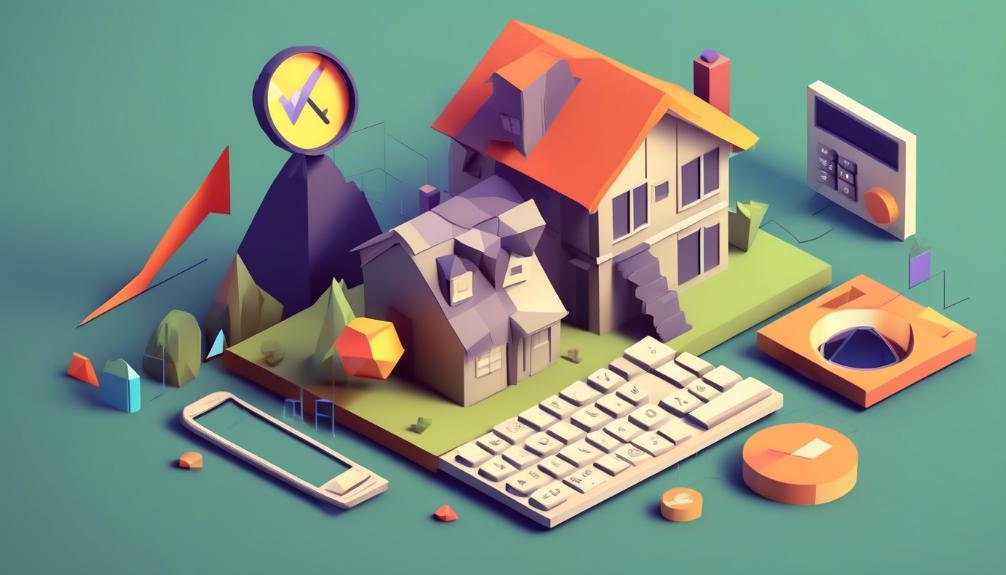Considering refinancing your mortgage can be as complex as navigating a tricky sea route. Like many homeowners, you might be looking for a better mortgage deal that suits your current financial needs, whether that's reducing your monthly payments, paying off your loan faster, or managing your debt more effectively. However, it's important to carefully consider the costs and benefits, the timing, and your financial health to ensure that refinancing is the right choice for you. In the upcoming sections, we'll explore the essential steps of the refinancing process. With clear guidance, this intimidating task can become a strategic move towards better financial health and greater peace of mind. Let's dive into the details of mortgage refinancing and discover how it might be a vital step in enhancing your financial situation.
To refinance your mortgage effectively, start by comparing current loan rates to your existing mortgage interest rate. If the rates have dropped significantly since you got your original loan, refinancing could lead to substantial savings. Next, evaluate the fees and closing costs involved in refinancing to make sure they don't outweigh the benefits. It's also crucial to assess your credit score, as a higher score can help you secure a better interest rate. When considering timing, aim to refinance when you can maximize financial benefits, such as when home values are high or when you have enough equity in your home. Specific examples, like using online mortgage calculators, can help you crunch the numbers and decide if refinancing makes sense for you. Remember to shop around and compare offers from different lenders to find the best deal. By taking these steps, you can navigate the refinancing process with confidence and potentially save money on your mortgage in the long run.
Assessing Current Finances

Before you think about refinancing your mortgage, it's important to look carefully at your current money situation to see if it makes sense for you. Take a good look at what you earn each month, what you spend, and how stable your finances are. If you own a home in Chambersburg, you should know about home equity. This is the part of your home that you fully own, which is the value of your home minus the mortgage you owe. Your home equity plays a big role in the refinance terms you might get.
Make sure to check the current interest rates and see how they compare to what you're paying now. It's not just about finding a lower rate. You also need to think about the fees for closing and how long you're planning to live in your house. If you won't be there for several years, the initial costs of refinancing could be more than what you'd save on your monthly bills.
Consider what you want to achieve financially in the long run. Do you want to lower your monthly payments, pay off your loan sooner, or use your home equity for a big purchase or to pay off other debts? What you want to achieve will help you decide if refinancing is a smart choice at this time. By being careful and thinking it through, you can use the equity from your Chambersburg home to get a mortgage that fits your financial situation better.
To help you understand better, let's say you're currently paying a 5% interest rate on your mortgage, but the current rate has dropped to 3.5%. Refinancing could save you money on interest. However, if the closing costs are high and you plan to move in two years, you might not save money overall. On the other hand, if you plan to stay in your home for ten more years, refinancing can offer substantial savings over the life of your loan. It's like shopping for a better deal on a long-term investment.
Understanding Refinancing Options
When you're thinking about refinancing your mortgage, it's important to know what choices you have and how they fit with your financial plans. There are two main kinds of refinancing: rate-and-term and cash-out.
With rate-and-term refinancing, the aim is to get a better interest rate or to change the length of your loan, or even both. If you want to lower your monthly mortgage payments or reduce the total interest you'll pay in the long run, this might be the right move for you.
Cash-out refinancing is different because you take out a new loan that's bigger than what you currently owe on your house and you get to keep the extra money. This could be helpful if you need funds for a big home renovation project, want to pay off other debts, or have other large costs to cover. But remember, this means you'll owe more money and it might take longer to pay off your house.
Each choice has its benefits, but there can be risks and costs too. It's a good idea to look at the numbers carefully. You might even want to get help from a real estate expert at Your Hometown Real Estate to make sure the refinancing option you pick is really the best for your wallet over time.
Let's break it down with examples: If your current mortgage has a 6% interest rate and you can refinance to a 4% rate, you could save a lot on interest. Or, if you owe $100,000 on your home but need $20,000 for a kitchen remodel, cash-out refinancing could let you borrow $120,000, use the $20,000 for the renovation, and then pay back the total over time.
Always check for spelling and grammar, and keep the conversation friendly and informative, just like you're talking to a neighbor. The goal is to make sure you have all the rich details you need to make a smart decision about refinancing.
Evaluating Interest Rates

If you're considering refinancing your mortgage, it's important to look at how different interest rates will affect your payments. A big reason to refinance is to get a lower interest rate, which can cut down your monthly payments and reduce the total interest you'll pay.
When you check out interest rates, think about what's happening in the market and your own finances. If interest rates have fallen since you first got your mortgage, you might be able to save some cash. But, a tiny drop in rates might not make up for the costs of refinancing.
To figure out if refinancing makes sense, calculate when you'll start saving more than it costs to refinance. This means looking at your new possible payment, the cost to close the deal, and how long you plan to live in your house. If you can save enough each month to make back the refinancing costs in a couple of years, and you're staying in your home longer than that, getting a new lower rate might be a good financial decision.
It's also smart to compare rates from a few different lenders to make sure you're getting a great deal. Since interest rates can change, timing your refinancing and shopping around can really pay off.
Let's say, for example, you got a mortgage with a 5% interest rate, but now you can refinance at 3.5%. If you're paying $1,500 a month on your mortgage, a lower rate could drop your payment to around $1,350. That's a saving of $150 a month. If your closing costs are $3,000, you'd need about 20 months to break even. If you're planning to stay in your home for five more years, refinancing could save you $6,000 after you break even.
Remember to write down all the numbers and talk to a financial advisor if you need help. They can help you understand whether refinancing is the right move for you. Keep your conversation informal and straightforward, just as if you're talking to a friend. This way, you'll have a clear picture of your potential savings and costs with refinancing.
Calculating Potential Savings
When you're thinking about refinancing your home loan, it's smart to sit down and do some math to see if it makes sense for your wallet. You should check out a few key numbers that will help you figure out if you'll actually save money by making the switch. Understanding these numbers can help you make a smart money move.
Here's what to look into:
- Monthly Savings: Look at your current mortgage payment and compare it to what you'd pay if you refinanced. This will show you how much you could potentially save every month.
- Break-even Analysis: Remember, you'll have to pay some fees upfront when you refinance. You should calculate how many months of savings it'll take to get that money back.
- Interest Costs: Find out how much interest you'll end up paying if you stick with your current mortgage versus if you refinance. This can help you see the long-term cost differences.
- Cash-out Refinance Details: If you're thinking about taking some cash out when you refinance, you need to work out how much you can get and how it'll change your payments and interest.
For example, if your current monthly mortgage payment is $1,500 and refinancing could reduce it to $1,300, you're looking at saving $200 a month. If the closing costs to refinance are $3,600, you'd divide that by your monthly savings ($3,600 / $200) to see that it would take 18 months to break even. After that, you're saving money.
Preparing Application Documents

After figuring out how much you could save by refinancing your mortgage, the next step is to get your paperwork together. This is a key part of the refinancing process because it gives the lender a clear picture of your financial health and shows that you're serious about this commitment. Start by collecting your latest pay stubs, your tax returns from the last two years, and your most recent bank statements. These documents provide proof of your income, your tax responsibilities, and how much you have saved, which helps lenders decide if you can afford the new loan terms.
Then, find the details of your current mortgage, like the latest statement, and any information about other loans you might have on your home, like a second mortgage or a home equity line of credit. This information tells the lender exactly what you still owe. Make sure you also have proof that you're keeping up with your homeowners insurance and property taxes, as this shows you're taking care of your basic homeowner duties.
Don't forget to also list your assets, including things like your investments and retirement savings. These can give lenders more confidence in your financial situation, which could help your refinancing application. Being thorough and organized with your documents can make the whole application process go more smoothly. Keep everything in order and easy to find to help speed up the refinancing process, so you can reach your financial goals faster.
Finalizing Refinance Terms
When you're looking to refinance your mortgage, it's all about getting a deal that makes your financial life better. Here's what to look for:
- Interest Rates: Hunt for the lowest rate to save the most money over time.
- Closing Costs: Check all the fees and make sure they don't cancel out the savings you're expecting.
- Loan Term: Think about the effects of making your loan period longer or shorter.
- Monthly Payments: Work out how new loan terms will fit into your monthly budget.
You want to adjust your loan to match your current situation and future plans. Maybe you're aiming to lower your monthly bills, get rid of your mortgage quicker, or get some cash for other needs. It's crucial to understand how these changes will play out for your finances. After you've found a refinance offer that feels right, you're ready to go ahead and finalize it. This is a smart move on your way to a more comfortable mortgage situation.
Here's a bit more detail to help you get it right:
- Interest Rates: Imagine if you could pay less interest on your mortgage. Look for the smallest rate you can find so that you pay less in the long run. It's like getting a discount on the cost of borrowing money.
- Closing Costs: Make sure you don't get hit with high fees when you close the deal. Think of it as making sure the price tag of refinancing doesn't eat up your savings.
- Loan Term: Whether you stretch it out or cut it short, changing the length of your loan alters your financial picture. Picking the right term can mean less strain on your wallet each month or fewer years tied to a mortgage.
- Monthly Payments: If you change your loan terms, it's like tweaking your monthly budget. You need to make sure it's a change you can handle.
Keep these points in mind and you'll be on your way to a refinance that fits your life like a glove.
Conclusion
You've done a great job figuring out how to refinance your mortgage. Here's something important to remember: by refinancing, many homeowners can lower their interest rate by at least 1%. This could mean saving a lot of money over the entire time you pay back the loan. Your hard work in researching and crunching the numbers has paid off, and now you're ready to save. Go for it—take the smart step towards improving your finances. You have the ability to change your mortgage and your future for the better.
When you refinance, you might be looking at different kinds of loans and terms. For example, you could switch from a 30-year mortgage to a 15-year one. This often means higher monthly payments, but you'll pay less interest in the long run. Or you might choose an adjustable-rate mortgage (ARM) if you're planning to move again soon. An ARM can offer lower initial rates, but they can change over time.
Before you decide, it's a good idea to talk to a financial advisor or use online tools like mortgage calculators. Websites like Bankrate or NerdWallet offer free calculators that can help you see how much you might save. Also, check out customer reviews for different lenders. Finding one that's highly rated for customer service can make the refinancing process smoother.
Always read the fine print before signing any documents. Look out for things like prepayment penalties or closing costs, which can affect your savings. With the right approach, refinancing your mortgage can be a smart financial move.

